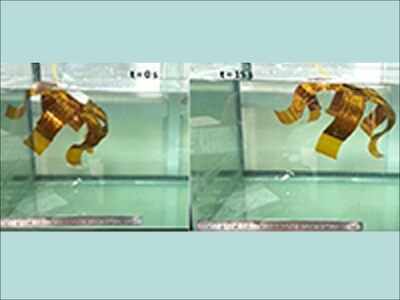- News
- Education News
- News
- IIT Indore develops jellyfish robot
Trending
This story is from July 24, 2019
IIT Indore develops jellyfish robot
Soft robotics is an emerging field and can be applied to mimic the gestures of living organisms

Soft robotics is an emerging field and can be applied to mimic the gestures of living organisms
Bio-inspired robots play a major role in the study and monitoring of marine life. Conventional bio-inspired robots are made of complicated rigid materials and mechanisms actuated by motors that limit their performance due to lack of flexibility. Conventional motor-based, bio-inspired robots are noisy and this limits its applicability for marine life monitoring as it may disturb the marine species.
The Mechatronics and Instrumentation Laboratory led by IA Palani, assistant professor of Mechanical Engineering at IIT Indore has developed a shape memory alloys (SMA) polymer-based soft robotic jellyfish for noiseless marine life monitoring using smart and soft materials.
"Soft robotics is an emerging domain in the field of robotics, which challenges the traditional engineering thinking. SMA can be a suitable option for flexible actuators technology to mimic the gestures of living organisms. It is smart material that can recover from induced deformation and revert to its memorised shape on heating," says Palani.
The developed robot has been tested in the laboratory environment and has achieved a motion of 1 cm/s. The device uses an SMA spring-based mechanism to mimic the flutter of the rear caudal fin of the fish, which creates the propulsive force to move the robotic fish.
"By utilising the combination of smart and soft materials, it is possible to mimic and create flexible structures and complex motions like real underwater living creatures," adds Palani.
The researchers are further working on the development of SMA actuated autonomous bio-inspired soft robotic fish and jellyfish, which can be extended for material transfer and rescue application in flooded zones and sea exploration. The institute will soon be collaborating with the National Institute of Oceanography to further refine the robot.
"The robot can be used for various applications such as studying the functioning of certain underwater species that are highly conscious of artificial cameras, understanding the behaviour of coral reefs and spying to avoid unwanted threats through water resources," adds Palani.
Bio-inspired robots play a major role in the study and monitoring of marine life. Conventional bio-inspired robots are made of complicated rigid materials and mechanisms actuated by motors that limit their performance due to lack of flexibility. Conventional motor-based, bio-inspired robots are noisy and this limits its applicability for marine life monitoring as it may disturb the marine species.
The Mechatronics and Instrumentation Laboratory led by IA Palani, assistant professor of Mechanical Engineering at IIT Indore has developed a shape memory alloys (SMA) polymer-based soft robotic jellyfish for noiseless marine life monitoring using smart and soft materials.
"Soft robotics is an emerging domain in the field of robotics, which challenges the traditional engineering thinking. SMA can be a suitable option for flexible actuators technology to mimic the gestures of living organisms. It is smart material that can recover from induced deformation and revert to its memorised shape on heating," says Palani.
The merits of the developed soft robot are noiseless actuation and simple flexible design that consumes less time for its fabrication. The continuous heating and cooling of the SMA wire-based polymer structure is responsible for expansion and contraction of its body with tentacles, which generate thrust to make the jellyfish robot to move in the water.
The developed robot has been tested in the laboratory environment and has achieved a motion of 1 cm/s. The device uses an SMA spring-based mechanism to mimic the flutter of the rear caudal fin of the fish, which creates the propulsive force to move the robotic fish.
"By utilising the combination of smart and soft materials, it is possible to mimic and create flexible structures and complex motions like real underwater living creatures," adds Palani.
The researchers are further working on the development of SMA actuated autonomous bio-inspired soft robotic fish and jellyfish, which can be extended for material transfer and rescue application in flooded zones and sea exploration. The institute will soon be collaborating with the National Institute of Oceanography to further refine the robot.
"The robot can be used for various applications such as studying the functioning of certain underwater species that are highly conscious of artificial cameras, understanding the behaviour of coral reefs and spying to avoid unwanted threats through water resources," adds Palani.
End of Article
FOLLOW US ON SOCIAL MEDIA










